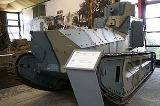
LK II
Encyclopedia
The Leichter Kampfwagen II (light combat car) or "LK II" was a development of the LK I
with the same layout, but incorporating a rotating turret on the rear superstructure armed with a 37mm Krupp
or Russian 57mm Sokol gun. Its armor was 8 to 14mm thick, which increased its total weight to 8.75 tons. Power was provided by a Daimler-Benz
Model 1910 4-cylinder 55-60 hp gasoline engine, giving a maximum speed of 14 to 18 km/h with range of 65–70 km.
A version armed with one or two 7.92mm Maxim
08/15 machine guns was also planned but progressed no farther than a project.
Only two prototypes were produced by June 1918, and were followed by orders for 580 tanks, which were never completed.
In 1929, five were rebuilt to create the Strv m/21-29 variant which was armed with a 37mm gun or two machine guns and was powered by a Scania-Vabis
engine. One of these improved vehicles was driven by Heinz Guderian
during a visit to Sweden in 1929.
The Germans later bought a main share of the Landsverk Company
and made Otto Merker the main designer and in 1931, it produced the Strv m/31 (L-10), which was the first tank produced in Sweden.
The Strv m/21-29 remained in service until 1938. A surviving example can be seen at the Deutsches Panzermuseum
at Munster
, Germany, and both strv m/21 and strv m/21-29 was displayed at the Axvall Tank Museum in Sweden.
LK I
The Leichter Kampfwagen or "LK I" was a German light tank prototype of the First World War.-History:The LK I was designed by Joseph Vollmer. It was based on a Daimler car chassis, using the existing axles to mount sprocket and idler wheels. Its design followed automobile practice, with a...
with the same layout, but incorporating a rotating turret on the rear superstructure armed with a 37mm Krupp
Krupp
The Krupp family , a prominent 400-year-old German dynasty from Essen, have become famous for their steel production and for their manufacture of ammunition and armaments. The family business, known as Friedrich Krupp AG Hoesch-Krupp, was the largest company in Europe at the beginning of the 20th...
or Russian 57mm Sokol gun. Its armor was 8 to 14mm thick, which increased its total weight to 8.75 tons. Power was provided by a Daimler-Benz
Daimler-Benz
Daimler-Benz AG was a German manufacturer of automobiles, motor vehicles, and internal combustion engines; founded in 1926. An Agreement of Mutual Interest - which was valid until year 2000 - was signed on 1 May 1924 between Karl Benz's Benz & Cie., and Daimler Motoren Gesellschaft, which had...
Model 1910 4-cylinder 55-60 hp gasoline engine, giving a maximum speed of 14 to 18 km/h with range of 65–70 km.
A version armed with one or two 7.92mm Maxim
Maxim gun
The Maxim gun was the first self-powered machine gun, invented by the American-born British inventor Sir Hiram Maxim in 1884. It has been called "the weapon most associated with [British] imperial conquest".-Functionality:...
08/15 machine guns was also planned but progressed no farther than a project.
Only two prototypes were produced by June 1918, and were followed by orders for 580 tanks, which were never completed.
Post-war Swedish service
Following the war, the Swedish government purchased parts for 10 examples in secrecy for the sum of 200,000 Swedish kronor. The parts were shipped as boiler plates and agricultural equipment and then assembled in Sweden as the Stridsvagn m/21 (Strv m/21 for short), which was essentially an improved version of the LK II prototype. The Strv m/21 was armed with a single 6.5mm machine gun.In 1929, five were rebuilt to create the Strv m/21-29 variant which was armed with a 37mm gun or two machine guns and was powered by a Scania-Vabis
Scania-Vabis
Scania-Vabis was a Swedish truck and car manufacturer. The company was formed from a merger of Scania with the firm of Vabis in 1911. The car production ended in 1929...
engine. One of these improved vehicles was driven by Heinz Guderian
Heinz Guderian
Heinz Wilhelm Guderian was a German general during World War II. He was a pioneer in the development of armored warfare, and was the leading proponent of tanks and mechanization in the Wehrmacht . Germany's panzer forces were raised and organized under his direction as Chief of Mobile Forces...
during a visit to Sweden in 1929.
The Germans later bought a main share of the Landsverk Company
AB Landsverk
Landsverk was founded in 1872 as Firman Petterson & Ohlsen. It was a heavy industry, manufacturingrailroad cars, harbour cranes and agricultural machinery. It was located in Landskrona, Sweden.-Early days:...
and made Otto Merker the main designer and in 1931, it produced the Strv m/31 (L-10), which was the first tank produced in Sweden.
The Strv m/21-29 remained in service until 1938. A surviving example can be seen at the Deutsches Panzermuseum
Deutsches Panzermuseum
The German Tank Museum is an armoured fighting vehicle museum in Munster, Germany, the location of the Munster Training Area camp. Its main aim is the documentation of the history of German armoured troops since 1917....
at Munster
Munster, Lower Saxony
Munster, also called Munster , is a small town in the district of Heidekreis, in Lower Saxony, Germany almost equidistant from Hamburg and Hanover. The town is home to the German Army's largest garrison and is situated between the two training areas of Munster North and Munster South. It is also...
, Germany, and both strv m/21 and strv m/21-29 was displayed at the Axvall Tank Museum in Sweden.

